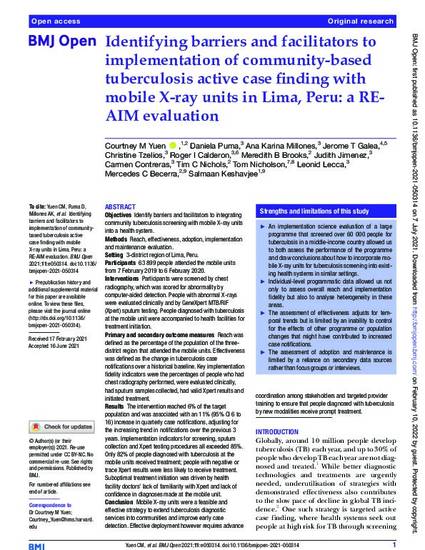
Objectives: Identify barriers and facilitators to integrating community tuberculosis screening with mobile X-ray units into a health system.
Methods: Reach, effectiveness, adoption, implementation and maintenance evaluation.
Setting: 3-district region of Lima, Peru.
Participants: 63 899 people attended the mobile units from 7 February 2019 to 6 February 2020.
Interventions: Participants were screened by chest radiography, which was scored for abnormality by computer-aided detection. People with abnormal X-rays were evaluated clinically and by GeneXpert MTB/RIF (Xpert) sputum testing. People diagnosed with tuberculosis at the mobile unit were accompanied to health facilities for treatment initiation.
Primary and secondary outcome measures: Reach was defined as the percentage of the population of the three-district region that attended the mobile units. Effectiveness was defined as the change in tuberculosis case notifications over a historical baseline. Key implementation fidelity indicators were the percentages of people who had chest radiography performed, were evaluated clinically, had sputum samples collected, had valid Xpert results and initiated treatment.
Results: The intervention reached 6% of the target population and was associated with an 11% (95% CI 6 to 16) increase in quarterly case notifications, adjusting for the increasing trend in notifications over the previous 3 years. Implementation indicators for screening, sputum collection and Xpert testing procedures all exceeded 85%. Only 82% of people diagnosed with tuberculosis at the mobile units received treatment; people with negative or trace Xpert results were less likely to receive treatment. Suboptimal treatment initiation was driven by health facility doctors’ lack of familiarity with Xpert and lack of confidence in diagnoses made at the mobile unit.
Conclusion: Mobile X-ray units were a feasible and effective strategy to extend tuberculosis diagnostic services into communities and improve early case detection. Effective deployment however requires advance coordination among stakeholders and targeted provider training to ensure that people diagnosed with tuberculosis by new modalities receive prompt treatment.
BMJ Open, v. 11, issue 7, art. e050314
Available at: http://works.bepress.com/jerome-galea/95/
